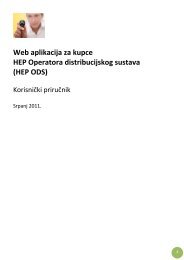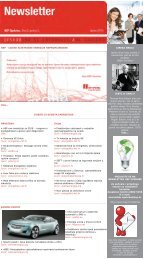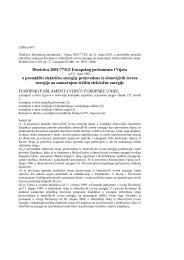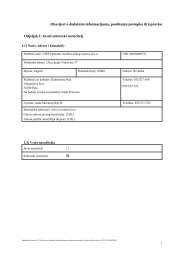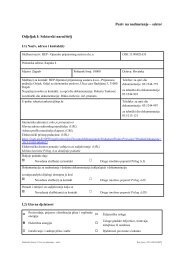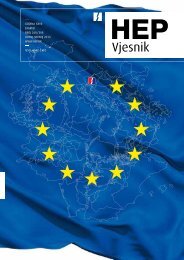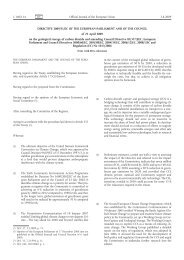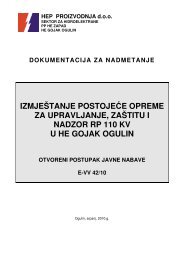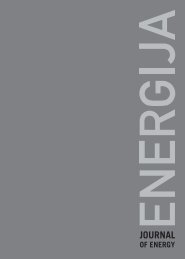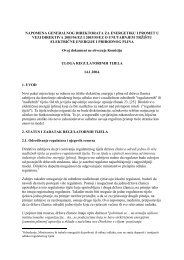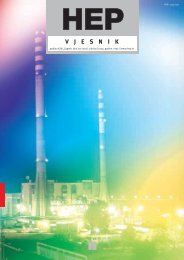Untitled
Untitled
Untitled
Create successful ePaper yourself
Turn your PDF publications into a flip-book with our unique Google optimized e-Paper software.
je porast potroπnje te zamjena postojeÊe opreme.Ti Ëimbenici se razlikuju kada je rijeË o razliËitimenergetskim subjektima te mogu znaËajnoutjecati na rezultate primjene metode ravnanjaprema mjerilu. Nadalje, iako se radi o istovrsniminvesticijama i istoj razini investicija, na rezultatemetoda ravnanja prema mjerilu moæe utjecatii razliËito vrijeme zapoËinjanja investicije i dinamikarealizacije investicije, kao i utvrappleena razinakvalitete opskrbe. Kvaliteta opskrbe kao funkcijaregulacije do sada se Ëesto promatrala kao zasebnafunkcija od funkcije regulacije cijena usluga,iako iskustva pokazuju da regulatorna tijela sveviπe nastoje razviti integrirane modele regulacijekojima bi se izbjegli svi dosadaπnji rizici primjenepojedine metode regulacije [9]. Tablica 1 prikazujepojednostavljeni primjer izraËuna dozvoljenog,odnosno od strane regulatornog tijela odobrenogprihoda regulatornim pristupom slaganja blokova.Vrijednosti za dozvoljene investicije (na godiπnjojrazini od 1 000 milijuna kuna), poËetni OPEX(2 400 milijuna kuna) i amortizaciju od prethodnihinvesticija (700 milijuna kuna) koje su pritome koriπtene na razini su vrijednosti HEP ODS-a[12]. Od vrijednosti prikazanih u literaturi pod[12] oduzeti su troπkovi koji po procjeni autora otpadajuna prikljuËke. Od regulatornih parametarautvrappleeni su:∑ regulatorno razdoblje od 4 godine,∑ faktor uËinkovitosti za OPEX u vrijednosti90 %, πto godiπnje iznosi smanjenje OPEX-a2,6 %,∑ linearna amortizacija na razdoblje od 20godina,∑ stopa povrata od 7 %.Iz tablice 1 vidljivo je da, ukoliko se svi parametridefiniraju kako je prethodno reËeno, dozvoljeniprihod subjekata koji obavljaju regulirane djelatnostikroz 4 godine regulatornog razdoblja ostajena skoro istoj razini. Regulatorna politika, odnosnoocjena potrebne razine poveÊanja uËinkovitosti,moæe imati znaËajan utjecaj na regulirani prihodenergetskog subjekta.3.2 Regulatorni pristup ukupnih troπkovaU regulatornom pristupu ukupnih troπkova regulatornotijelo kada utvrappleuje razinu opravdane uËinkovitostine razlikuje izmeappleu OPEX-a i CAPEX -a,stoga faktor uËinkovitosti X primjenjuje na sumuOPEX-a i CAPEX-a, odnosno na ukupan troπak(TOTEX) (tablica 2). U ovom sluËaju regulatornotijelo ne mora utvrappleivati odvojeno opravdanu razinuinvesticija za sljedeÊe regulatorno razdoblje,veÊ analizu provodi za ukupne troπkove. U ovompristupu regulatorno tijelo utvrappleuje X-faktor naosnovi razine uËinkovitosti iz prethodnih regulatorreplacementof existing equipment. These factorsdiffer among various energy entities and can significantlyinfluence the results of the benchmarkingmethod applied. Moreover, although this concernsthe same types of investments and the same level ofinvestment, the results of the benchmarking methodcan be affected by differing times for the beginningof investments and the dynamics of the implementationof the investments, as well as the determinedlevel of the quality of the supply. Up to now, thequality of the supply as a function of regulationhas been frequently viewed as a function that isseparate from the function of the regulation of theprices for services, although experience shows thatthe regulatory bodies are increasingly attempting todevelop integrated models of regulation that avoidall the risks inherent in the individual regulatorymethods that have been applied [9]. Table 1 showsa simplified example of the calculation of allowedrevenue, i.e. revenue authorized by the regulatorybody, using the building block approach. The valuesfor allowed investments (at an annual level of1 000 million kunas), the initial OPEX (2 400 millionkunas) and depreciation from previous investments(700 million kunas) were previously used atthe level of the HEP Distribution System Operator(HEP ODS d,o.o.) [12]. From the values presentedin the literature under [12], expenditures have beendeducted that the authors consider to be connectioncosts. The following regulatory parameters havebeen established:∑ a regulatory period of 4 years,∑ a efficiency factor for OPEX with a value of90 %, which amounts to an annual reduction inOPEX of 2,6 %,∑ linear depreciation during a period of 20 years,∑ a rate of return of 7 %.From Table 1, it is evident that, when all the parametersare defined as above, the allowed revenueof a entities performing regulated activities during a4-year regulatory period remains at nearly the samelevel. Thus, regulatory policy, i.e. the assessmentof the necessary level of increasing efficiency, canhave a significant impact on the regulated revenueof an energy entity.3.2 The regulatory approach of total expenditureIn the regulatory approach of total expenditure,when the regulatory body determines the level ofjustified efficiency it does not differentiate betweenOPEX and CAPEX, and therefore the efficiency factorX is applied to the sum of OPEX and CAPEX,i.e. to the total expenditure (TOTEX) (Table 2).Therefore, in this case the regulatory body does notneed to determine the justified levels of investmentseparately for the subsequent regulatory period butŠtritof, I., KleËina, F., Regulatorna politika i njen utjecaj ..., Energija, god. 56(2007), br. 5., str. 554-583Štritof, I., KleËina, F., Regulatory Polica and Its Impact ..., Energija, vol. 56(2007), No. 5, pp. 554-583568



